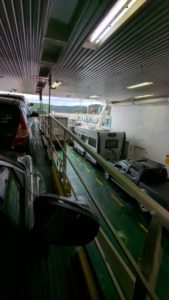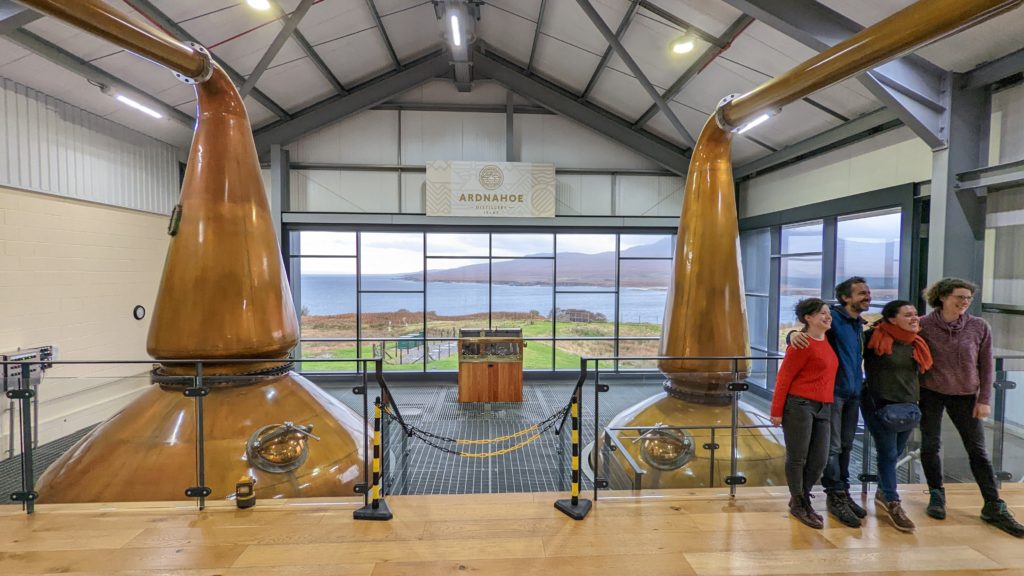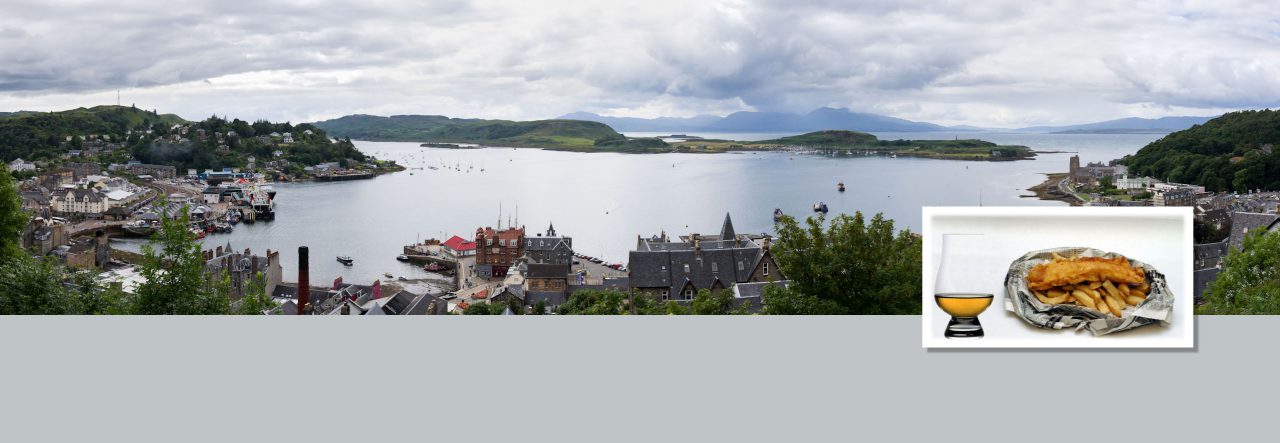In which I intentionally drive the wrong direction, unintentionally drive the normally-right-but-wrong-today direction, drive the right direction for three hours, ride a FERRY!, and visit a distillery…
Bit of an early start today as we had about a three hour drive form the city to catch our ferry to Islay at 1300, and I had to get in to the city first to collect John. So, awake at awcrap-it’s-early o’clock to repack a few things, shower (to be nice to my travelling partner), and then drive the whopping 15-20 mins from the northenmost suburb of Glasgow to, literally, the city center.
Having spent the last “few” years living in the US, I now have a very skewed perspective on driving distances in the UK. What seemed like an age to drive all those years ago when I was living here kinda throw me off now as I think “What speed was I driving to get here this fast!?!?” For example, back home in the US, it’s almost exactlty 2 miles from our driveway to the main road, along an unpaved road, so it takes about 5-6 mins. When I was 5-6 mins into the drive in to Glasgow this morning, I was approaching half of the distance, and had to double-check myself. More than once. It’s all do much closer together. It’s so weird. I mean, I used to haaaate the drive from Glasgow to Edinburgh ’cause it took sooo looooonnng. All 45 miles of it. See what I mean! Anyhoo…
I collected John and his luggage at about 0910, which would get us to Kennacraig Ferry Port by about 1145-1200. Perfick. The in-car SatNav decided on a slightly different route to the motorway than Google Maps, but I liked the motorway entrance it was pointing to better, so off we went…
…And promptly ran into a “Road Closed” sign (figuratively, but only just) as wd found that the entrance ramp to the motorway was closed and were being diverted. In a big loop. Past the road I picked John up on, and right around to (you guessed it) the entrance Google Maps had suggested. It itself was engulfed in road work, but at least viable. So, fine, a 10 minute detour, but we’re on our way.
The rest of the drive was unveventful… Gorgeous, but uneventful. Doon the watter (followed the River Clyde) tae Dumbarton, aff up Loch Lomond side, didnae Rest but were Thankful nonetheless*, up and doon some wee hills, through Inverary (saluted the Duke**), along an unexpected single-track road “shortcut” that the SatNav seemed to think was a main road, and then to the ferry terminal. Where I swear I didn’t squee. That didn’t happen until we drove on to the ferry.

I have this thing about travelling on CalMac ferries (I may have mentioned it before). I just love it. I could sail on them all day quite happily. I think it’s because I associated them with going on holiday as a kid, but it could just be that they’re big, maneuver like they’re auditioning for the seaborne equivalent of the Fast and Furious films, and I kinda like being on the water. The maneuvering thing isn’t much of an exaggeration: these boats turn on a penny and can dock in crazy weather. I once watched one of these beasties dock at Port Ellen: it seemed like it was going to charge the quay, and a few infrequent travellers started muttering concerns; at the last moment, it performed the ferry equivalent of handbrake turn, was suddenly approaching backwards, before coming to a complete halt in perfect position, loading/unloading ramp already on its way down. So cool!!

Today, we were travelling on the MV Finlaggan, and there was a feature I had managed not to notice the last time I sailed on her – she has a second storey half-deck for cars. And we got to be on it! And yes I was unjustifiably excited about this. You drive up the incline, which is blocking half of the main level, and then when full, it just lifts up the back end until it’s level. When we arrived at the destination, they cleared out the vehicles under us, dipped our noses, and off we went. I was far too thrilled by this.
It was a grey and breezy day, but the crossing was pretty smooth. I spent a wee while on deck, but mostly we stayed seated at a table inside at the bow, next to the cafe where we snagged lunch.
When we arrived at Port Askaig, we had the long, arduous trip to our first distillery tour. Nope, we don’t mess about. There’s whisky to drink on this island and we ain’t wasting time. To be fair, on my very first trip to Islay with the ladies and my folks, we pulled off the ferry, saw the sign for Caol Ila, followed it, parked, and had our first dram in our hands within, oh, five minutes or so. This time, we were hitting Ardnahoe, which was a 10 minute drive away, so we weren’t going to beat that record. No worries. We’re in no rush. Not really. Well, not much. OK, shut up.

Ardnahoe is the 9th and newest distillery on Islay (but not for long); it is the second smallest distillery on Islay (but not for long); and is family owned by the folks behind the Hunter Laing independent bottler. They’ve been in the whisky business for 80 years, and both father and one of the two sons spent some time working at the Bruichladdich distillery on Islay, which is probably why they insisted on doing things the traditional Islay way, and almost certainly why they were able to drag the infamous Jim McEwan (formerly of Bruichladdich) out of retirement to help them develop their new distillery.
The distillery is located at the North end of the island, down the same horrifically surfaced single-track road as Bunnahabhain, just a little closer to Port Askaig. While they insist that the location was chosen for the nearby Loch Ardnahoe (their water source, just across the road from the distillery), and vehemently deny that it was chosen for the spectacular views across the Sound of Islay to the Paps of Jura, framed by the window wall in their stillhouse, I frankly don’t believe it. It was chosen in at least some small way for the view. And justifiably so. It’s stunning, even on a grey and windy day.
Our tour was the last “Spirit of Ardnahoe” tour of the day, at 1600; Rebecca was our tour guide for the day, and did a lovely job.
Ardnahoe translates into the Height of the Hollow, and again is named after the loch across the road, which itself claims to be the deepest on Islay. Which is handy, because it means that there’s no dry period in the summer when the temperatures threaten to glance in the direction of “warm” and the rain stops for a couple of weeks, more out of suprirse than anything else. Most distilleries on the island “go dark” for these two weeks, and perform maintenance, give staff time off, etc. Ardnahoe observes the same dark period, but purely out of respect for tradition and, presumably, to prevent a rebellion amongst the staff. The aforementioned loch provides water for both distillation and the cafe (filter three times for consumption, twice for distillation), and a wee tidbit is to ask for a glass of water to see the orange-y tint to it (and presumably to taste the peat).
The process is much the same as other distilleries. Their grist comprises 20% husk, 70% grit, and 10% flour, a fairly typical ratio. Their mill is of the Vickers Boby variety, another spectacularly good manufacturer whose standards were so hight that they put themselves out of business because their mills never failed. Seriously, this one is just over 100 years old. It’s been maintained once since being installed on site, by Ronnie Lee. This is an important name as he is, quite literally, the only remaining person in the world qualified to maintain and repair Boby mills. Rumor has it that he’s teaching his sons, so let’s hope that they like whisky (and don’t open a competing distillery of their own).
2.5 tons of grist is added to their mash tun, which bathes it once in 10,500 liters of water at 63.5 C for 100 mins, then a second time in 3,500 liters of water at 80-85 C for about 70 mins. Both of those liquids are pumpted into one of four washbacks. The remaining draff is bathed one last time in 8,500 liters of water at 90-95 C for 40 mins, and that liquid is stored in the Hot Liquid Tanks to be use for the first bath of the next run. The draff is sent to become cattle feed, resulting in what we are assured is the best and tastiest beef on Islay.
The washbacks, where fermentation occurs, are made of Oregon Pine. Fun fact I hadn’t heard before was that Oregon Pine washbacks, compared to their stainless steel counterparts, maintain a more consistent temperature in different seasons. (This played nicely into information we received from Marcos at The Clydeside Distillery, which was that fermentation is particularly sensitive to temperature changes). 70kg of yeast is added to the 25,000 liters of wort and then nature takes its course. Within about 50 hours, the yeast is dead, but the wash is left to sit for another 20 hours to keep drawing flavors.

As mentioned above, the stillhouse at Ardnahoe is spectacular. I think that it and Clydeside may be neck-and-neck for the best view. There are just the two stills: one wash still and one spirit still. They are both attached to traditional worm tub condensers by the most ridiculously long lyne arms that I’ve ever seen. Fact: at 23.5 ft, they’re the longest lyne arms in Scotland. This is done intentionally to maximize copper contact, in part because of the worm tubs. The worm tub condenser was the original design of condenser in Scottish distilling, but has been replaced in most distilleries by shell and tube condensers. There is overall less copper contact in a worm tub condenser, so fewer of the meatier flavors are removed by the copper-alcohol reactions. So, Ardnahoe put in massively long lyne arms to compensate. They’re quite impressive to look at.
The wash still has a 12,500 liter capacity, so one run from a washback equals two runs in the wash still. The spirit still is 8,500 liters. The Heads run for about 23 mins, the Heart for 2 hrs 30-40 mins, the Tails doesn’t matter 🙂
Sadly, at the moment, there is almost no space to age their spirit on the island. They’re about to build warehouses a little further north on the island, but for now, all new make is sent to Glasgow (East Kilbride, specifically) for aging in warhouses already owned by Hunter Laing. Interesting to note that this means their first batches of whisky (aged in Glasgow) will have different characteristics than those aged later on the island. It’ll be interesting to hear how they pitch that, or if they pitch it.
Also sadly, they’re not making any of their stock available for sampling, even on tours. No new make spirit, and none of their three-and-a-bit year old first run. They’re technically just over four years old now, but rumor around the distillery is that they’re aiming for a minumum of five years. Now, normally, this would be a tad risky for a new distillery – no income from your product for five or more years? How do we pay the bills? Oh, yeah, right, independent bottler with 80 years in the industry. They can wait.
Full disclosure: the tiny amount of aging space they do have is mostly filled with 500 privately owned casks, but those folks with some cash that bought in at the beginning. Lucky sods.
We did get a dram at the end of the tour, though. You got to choose from three of the four Journey series, or the Hunter Laing bottling of Speybank. I chose to finish that bottle (there was only a wee bit left) as I bought a sample kit of all four of the Journey series.
———————————–
Right, well, that’s distillery one of nine in the bag. Time to head to our hotel.
John had us booked in to the Ballygrant Inn and Restaurant. Nice little place just a few mins down the road from Port Askaig, with an obscene whisky selection behind their bar. No, it wasn’t a coincidence. What on earth would make you think that?
Dinner was phenomenal (Piri Piri Smoked Mackerel starter, followed by Islay Beef and Guniness pie with tatties and greens). The drams weren’t half bad either: Tamdhu The Dalbeallie (original), Lagavulin Distillery Exclusive Natural Cask Strength, and an original Laphroaig 15yr.
Will be sleeping well tonight. Which is good, for tomorrow, we walk!
*There’s a stretch if road, up into the hills, that’s called “The Rest and Be Thankful”. It dates back to a time before cars were a thing and travellers would reach the top of the steep hill and, well, you get it.
**The Duke or Argyll is the clan chief of the Campbells of Argyll – making him my clan chief by way of the Burns – and resides in Inverary Castle. I met his dad, the former Duke, years ago when mum, sister, and I were visiting the castle. Hilarious, really. We were just wandering about enjoying the museum when mum grabbed us weans by the wrists and yoinked us off to stand (formally) in front of this guy in a kilt that had just walked down the stairs from the restricted section. Mum introduced herself by maiden name, along with her two kiddiewinks. We hadnae a clue who this bloke was, but mum seemed to think he was important, so there we go. We realised afterwards, of course, who he was, but the various other tourists all around us certainly didn’t and all wondered what the fuss was about. The Duke himself was quite charming and chatted with us for a few mins before excusing himself to go do Dukey or Clan Chiefy business (signing paperwork, beheading a mortal enemy, something like that).
